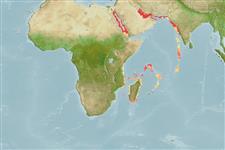Issue
This species is a synonym of Equulites berbis (Valenciennes 1835) according to Suzuki & Kimura, 2023 (Ref. 130900). This summary page will be deleted.
Environment: milieu / climate zone / depth range / distribution range
Écologie
marin démersal; profondeur 10 - 77 m (Ref. 122739). Tropical; 30°N - 16°N, 32°E - 59°E
Western Indian Ocean: endemic to northern Red Sea, and Lessepsian migrant to Mediterranean Sea.
Taille / Poids / Âge
Maturity: Lm ? range ? - ? cm
Max length : 13.4 cm SL mâle / non sexé; (Ref. 120651)
Description synthétique
Clés d'identification | Morphologie | Morphométrie
Épines dorsales (Total) : 7; Rayons mous dorsaux (Total) : 15 - 16; Épines anales: 3; Rayons mous anaux: 15 - 16.
Inhabits coastal waters and feeds on bottom invertebrates. Reproduces in the summer months (Ref. 6757).
Life cycle and mating behavior
Maturité | Reproduction | Frai | Œufs | Fécondité | Larves
Roux, C., 1986. Leiognathidae. p. 856-857. In P.J.P. Whitehead, M.-L. Bauchot, J.-C. Hureau, J. Nielsen and E. Tortonese (eds.) Fishes of the north-eastern Atlantic and the Mediterranean. UNESCO, Paris. Vol. 2. (Ref. 6757)
Statut dans la liste rouge de l'IUCN (Ref. 130435: Version 2024-2)
Menace pour l'homme
Harmless
Utilisations par l'homme
Pêcheries: commercial
Outils
Articles particuliers
Télécharger en XML
Sources Internet
Estimates based on models
Preferred temperature (Ref.
123201): 24.5 - 29.3, mean 26.5 °C (based on 82 cells).
Phylogenetic diversity index (Ref.
82804): PD
50 = 0.5010 [Uniqueness, from 0.5 = low to 2.0 = high].
Bayesian length-weight: a=0.01122 (0.00842 - 0.01496), b=3.09 (3.03 - 3.15), in cm total length, based on LWR estimates for this species (Ref.
93245).
Niveau trophique (Ref.
69278): 3.5 ±0.37 se; based on food items.
Résilience (Ref.
120179): Milieu, temps minimum de doublement de population : 1,4 à 4,4 années (Preliminary K or Fecundity.).
Fishing Vulnerability (Ref.
59153): Low vulnerability (10 of 100).
